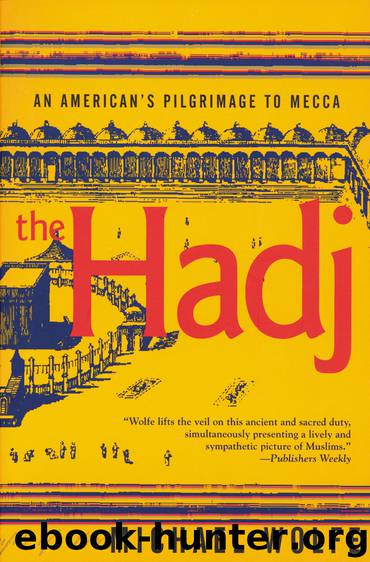The Hadj by Michael Wolfe

Author:Michael Wolfe
Language: eng
Format: epub
Publisher: Grove Atlantic
The Bible casts Hagar in a passive role. Weeping, lost in a wilderness, she sits with eyes averted, unable to watch her child's death. Muslim legend describes a more active agent. In these stories Hagar runs between two hills, passionately seeking water in a desert. Her drive is emotional, physical, existential. At stake are faith and her family's survival.
The course of Hagar's quest, I now discovered, is still in active use within the building. Our last labor of the night was a ritual jog between the hills. The rite, called sa'y, takes place in the concourse on the long side of the key. To reach it, we crossed the Ka'ba floor, saluted the stone, then walked out of the courtyard, heading south.
A series of arches led through cloisters to a gate. Here the head of the mosque and its shaft were joined, forming a marble lane called the mas'a. Later I heard one hadji refer to it as the racecourse. I was unprepared for the length of this passage: a quarter-mile stretch of covered mall, split in two lanes for pilgrims coming and going.
The course began at the top of a hill called al-Safa, jutting from the base of Mount Qubays. It ended at the second hill, al-Marwa, in the north of the building. I had never seen hillocks housed inside a building; domes had been set in the ceilings to accommodate their crowns. A complete lap covered about eight hundred yards. Here, as around the Ka'ba, old age and illness were shown consideration. Down the center of the mas'a, on a median strip dividing the two lanes, frail pilgrims were being wheeled in rented chairs.
Saluting the shrine at the top of each relay, we completed seven lengths, or about two miles. My legs began to throb in the third round. The contrast between the mystical tawaf and this linear, headlong rush could not have been greater. Wandering loosely between fixed points, doubling back on itself around the hills, the rite expressed persistence and survival. The sa ‘y was not a circle dance. Its intent seemed to be to instill compassion for the victimized and the exiled. This was the mall of necessitous desire.
We finished our run and stepped down onto a ramp beside al-Marwa. By now our ihram towels were streaked with dirt and sweat. We had come through the ‘umrah. We were muta ‘ammirin. As we stood shaking hands (Mohamed Fayez high-fived me), two self-appointed barbers stepped from the wings, offering their services. In order to put aside the ihram clothes, a pilgrim who plans to return to them for the hadj is supposed to have a desacralizing haircut. Generally this means a token snip of three or four neck hairs. When it was done, we returned to Bab al-Malik for our sandals.
Download
This site does not store any files on its server. We only index and link to content provided by other sites. Please contact the content providers to delete copyright contents if any and email us, we'll remove relevant links or contents immediately.
| Hadith | History |
| Law | Mecca |
| Muhammed | Quran |
| Rituals & Practice | Shi'ism |
| Sufism | Sunnism |
| Theology | Women in Islam |
The History of Jihad: From Muhammad to ISIS by Spencer Robert(2210)
Nine Parts of Desire by Geraldine Brooks(2011)
The Turkish Psychedelic Explosion by Daniel Spicer(1990)
The First Muslim The Story of Muhammad by Lesley Hazleton(1886)
The Essential Rumi by Coleman Barks(1634)
The Last Mughal by William Dalrymple(1573)
Trickster Travels: A Sixteenth-Century Muslim Between Worlds by Davis Natalie Zemon(1546)
1453 by Roger Crowley(1488)
by Christianity & Islam(1351)
God by Aslan Reza(1335)
Muhammad: His Life Based on the Earliest Sources by Martin Lings(1291)
A Concise History of Sunnis and Shi'is by John McHugo(1278)
Magic and Divination in Early Islam by Emilie Savage-Smith;(1202)
The Flight of the Intellectuals by Berman Paul(1182)
No God But God by Reza Aslan(1160)
Art of Betrayal by Gordon Corera(1136)
What the Qur'an Meant by Garry Wills(1122)
Getting Jesus Right: How Muslims Get Jesus and Islam Wrong by James A Beverley & Craig A Evans(1081)
The Third Choice: Islam, Dhimmitude and Freedom by Durie Mark & Ye'or Bat & Bat Ye'or(1069)
